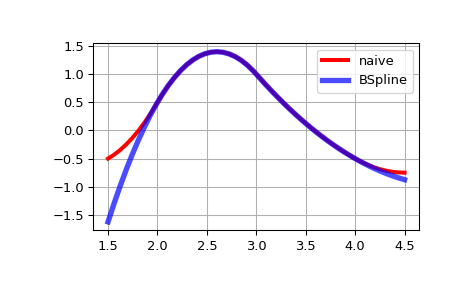BSpline#
- class scipy.interpolate.BSpline(t, c, k, extrapolate=True, axis=0)[源代码][源代码]#
B样条基底中的单变量样条。
\[S(x) = \sum_{j=0}^{n-1} c_j B_{j, k; t}(x)\]其中 \(B_{j, k; t}\) 是度数为 k 和节点 t 的 B 样条基函数。
- 参数:
- tndarray, 形状 (n+k+1,)
结
- cndarray, 形状 (>=n, …)
样条系数
- k整数
B样条次数
- 外推布尔值或 ‘periodic’,可选
是否在基础区间
t[k] .. t[n]之外进行外推,或者返回 nans。如果为 True,则在基础区间上激活的 b-样条函数的第一段和最后一段进行外推。如果为 ‘periodic’,则使用周期性外推。默认为 True。- 轴int, 可选
插值轴。默认值为零。
- 属性:
- tndarray
结向量
- cndarray
样条系数
- k整数
样条度数
- 外推布尔
如果为 True,则外推 b-spline 函数在基区间上活动的第一段和最后一段多项式。
- 轴整数
插值轴。
tck元组等同于
(self.t, self.c, self.k)(只读)。
方法
__call__(x[, nu, extrapolate])评估一个样条函数。
basis_element(t[, extrapolate])返回一个B样条基元素
B(x | t[0], ..., t[k+1])。derivative([nu])返回表示导数的B样条。
antiderivative([nu])返回表示不定积分的B样条。
integrate(a, b[, extrapolate])计算样条的定积分。
insert_knot(x[, m])在 x 处插入一个重数为 m 的新节点。
construct_fast(t, c, k[, extrapolate, axis])构建一个样条而不进行检查。
design_matrix(x, t, k[, extrapolate])返回一个以 CSR 格式稀疏数组表示的设计矩阵。
from_power_basis(pp[, bc_type])从幂基的分段多项式构造B样条基的多项式。
注释
B样条基元素通过定义
\[ \begin{align}\begin{aligned}B_{i, 0}(x) = 1, \textrm{如果 $t_i \le x < t_{i+1}$, 否则 $0$,}\\B_{i, k}(x) = \frac{x - t_i}{t_{i+k} - t_i} B_{i, k-1}(x) + \frac{t_{i+k+1} - x}{t_{i+k+1} - t_{i+1}} B_{i+1, k-1}(x)\end{aligned}\end{align} \]实现细节
对于一个度数为 k 的样条,至少需要
k+1个系数,因此n >= k+1。额外的系数,即j > n的c[j],将被忽略。度数为 k 的 B 样条基元素在 基区间 上形成了一个单位分割,
t[k] <= x <= t[n]。
参考文献
[1]Tom Lyche 和 Knut Morken,样条方法,http://www.uio.no/studier/emner/matnat/ifi/INF-MAT5340/v05/undervisningsmateriale/
[2]Carl de Boor, A practical guide to splines, Springer, 2001.
示例
将B样条的递归定义翻译成Python代码,我们有:
>>> def B(x, k, i, t): ... if k == 0: ... return 1.0 if t[i] <= x < t[i+1] else 0.0 ... if t[i+k] == t[i]: ... c1 = 0.0 ... else: ... c1 = (x - t[i])/(t[i+k] - t[i]) * B(x, k-1, i, t) ... if t[i+k+1] == t[i+1]: ... c2 = 0.0 ... else: ... c2 = (t[i+k+1] - x)/(t[i+k+1] - t[i+1]) * B(x, k-1, i+1, t) ... return c1 + c2
>>> def bspline(x, t, c, k): ... n = len(t) - k - 1 ... assert (n >= k+1) and (len(c) >= n) ... return sum(c[i] * B(x, k, i, t) for i in range(n))
注意,这是一种评估B样条的低效(尽管直接)方法——这个样条类以一种等效但更高效的方式实现了它。
在这里,我们在基区间
2 <= x <= 4上构造一个二次样条函数,并与直接评估样条的简单方法进行比较:>>> from scipy.interpolate import BSpline >>> k = 2 >>> t = [0, 1, 2, 3, 4, 5, 6] >>> c = [-1, 2, 0, -1] >>> spl = BSpline(t, c, k) >>> spl(2.5) array(1.375) >>> bspline(2.5, t, c, k) 1.375
请注意,在基本区间之外的结果会有所不同。这是因为
BSpline会外推基本区间上活动的 B 样条函数的第一段和最后一段多项式。>>> import matplotlib.pyplot as plt >>> import numpy as np >>> fig, ax = plt.subplots() >>> xx = np.linspace(1.5, 4.5, 50) >>> ax.plot(xx, [bspline(x, t, c ,k) for x in xx], 'r-', lw=3, label='naive') >>> ax.plot(xx, spl(xx), 'b-', lw=4, alpha=0.7, label='BSpline') >>> ax.grid(True) >>> ax.legend(loc='best') >>> plt.show()
